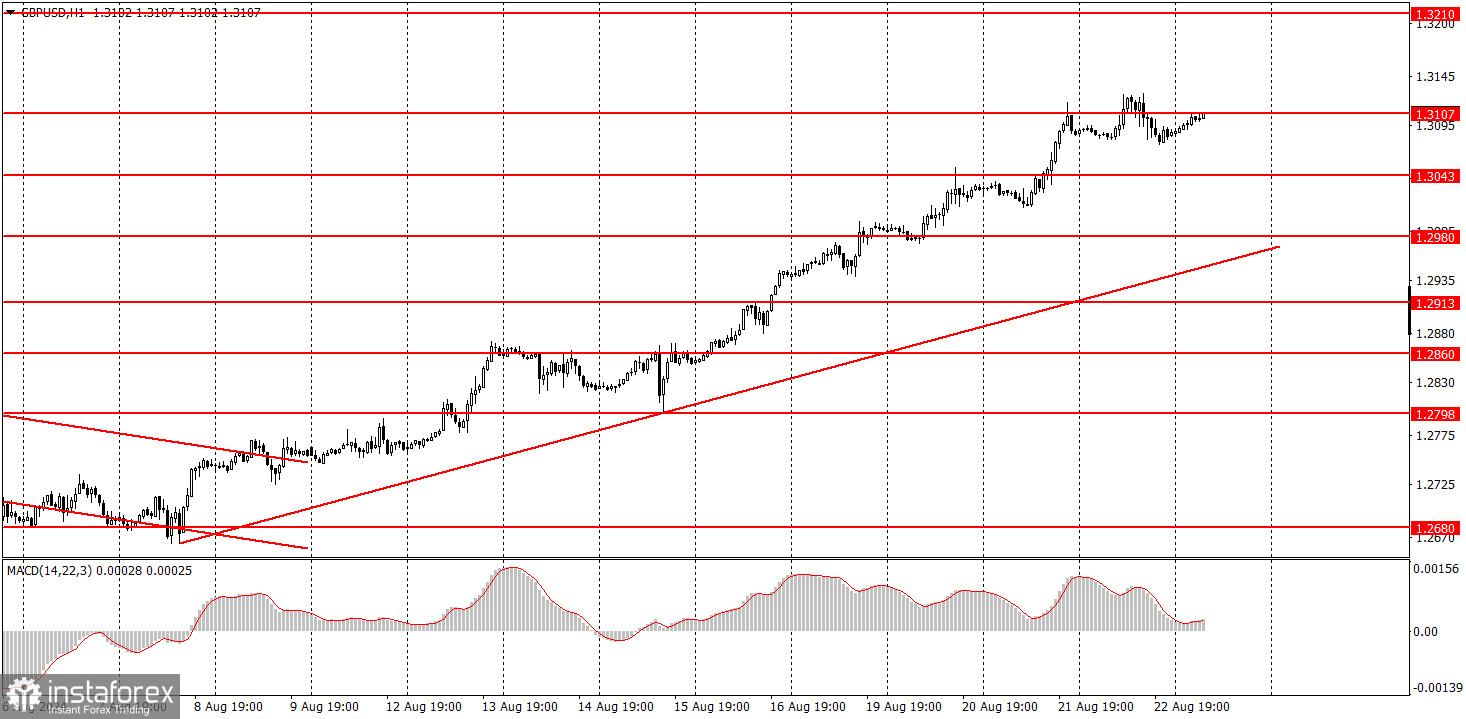Analysis of macroeconomic reports:

No macroeconomic events are scheduled for Friday. Therefore, until the Jackson Hole symposium, the market will have nothing to react to. During this period, we will likely see movements similar to yesterday's for the British pound. Both currency pairs remain in an upward trend, and there are no signs of a reversal at the moment. The US dollar has been falling all week in anticipation of Federal Reserve Chair Jerome Powell's speech today.
Analysis of fundamental events:
The fundamental events to note are the speeches by Powell and Bank of England Governor Andrew Bailey. It is impossible to predict in advance what Powell and Bailey will discuss. One can only assume that both heads will adopt a dovish tone. However, it is less likely to expect a dovish tone from Powell compared to Bailey. We have already mentioned that the US economy remains stable, as does the labor market. The unemployment rate is not high enough to sound the alarm. The Fed may lower rates in September, but it is unlikely to do so at every meeting until the end of the year. Market expectations in this regard are again excessively high, and based on these expectations, the dollar continues to plummet.
General conclusions:
During the week's final trading day, both currency pairs might experience a slight decline. However, it is impossible to predict how the market will react to Powell and Bailey's speeches. Therefore, any outcome should be anticipated for the evening. There is a suggestion that any dovish rhetoric from Powell might already be priced in, as the dollar has been falling all week. In this case, we might see the long-awaited dollar rise today. However, this is only speculation.
Basic rules of the trading system:
1) The strength of a signal is determined by the time it takes for the signal to form (bounce or level breakthrough). The less time it took, the stronger the signal.
2) If two or more trades around a certain level are initiated based on false signals, subsequent signals from that level should be ignored.
3) In a flat market, any currency pair can form multiple false signals or none at all. In any case, it's better to stop trading at the first signs of a flat market.
4) Trades should be opened between the start of the European session and midway through the U.S. session. After this period, all trades must be closed manually.
5) In the hourly time frame, trades based on MACD signals are only advisable amidst substantial volatility and an established trend confirmed by a trendline or trend channel.
6) If two levels are too close to each other (5 to 20 pips), they should be considered support or resistance.
7) After moving 20 pips in the intended direction, the Stop Loss should be set to break even.
What's on the charts:
Support and Resistance price levels: targets for opening long or short positions. You can place Take Profit levels near them.
Red lines: channels or trend lines that depict the current trend and indicate the preferred trading direction.
The MACD (14,22,3) indicator, encompassing both the histogram and signal line, acts as an auxiliary tool and can also be used as a source of signals.
Important speeches and reports (always noted in the news calendar) can profoundly influence the movement of a currency pair. Hence, trading during their release calls for heightened caution. It may be reasonable to exit the market to prevent abrupt price reversals against the prevailing trend.
Beginners should always remember that not every trade will yield profit. Developing a clear strategy and effective money management is key to success in trading over a long period.
 English
English 
 Русский
Русский Bahasa Indonesia
Bahasa Indonesia Bahasa Malay
Bahasa Malay ไทย
ไทย Español
Español Deutsch
Deutsch Български
Български Français
Français Tiếng Việt
Tiếng Việt 中文
中文 বাংলা
বাংলা हिन्दी
हिन्दी Čeština
Čeština Українська
Українська Română
Română


